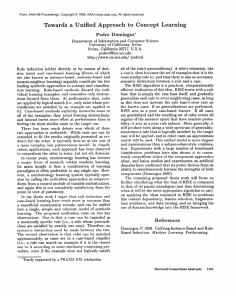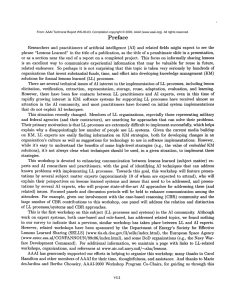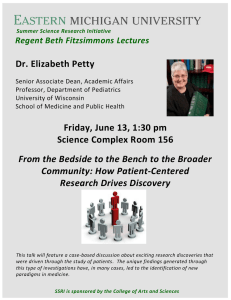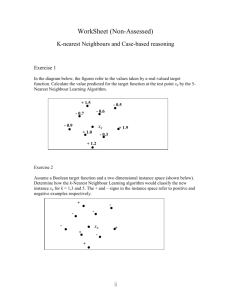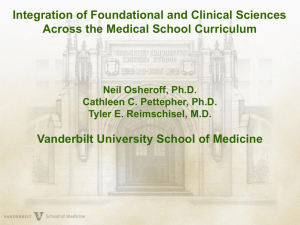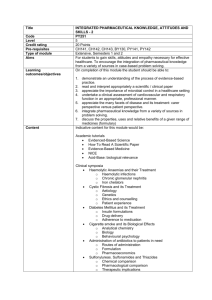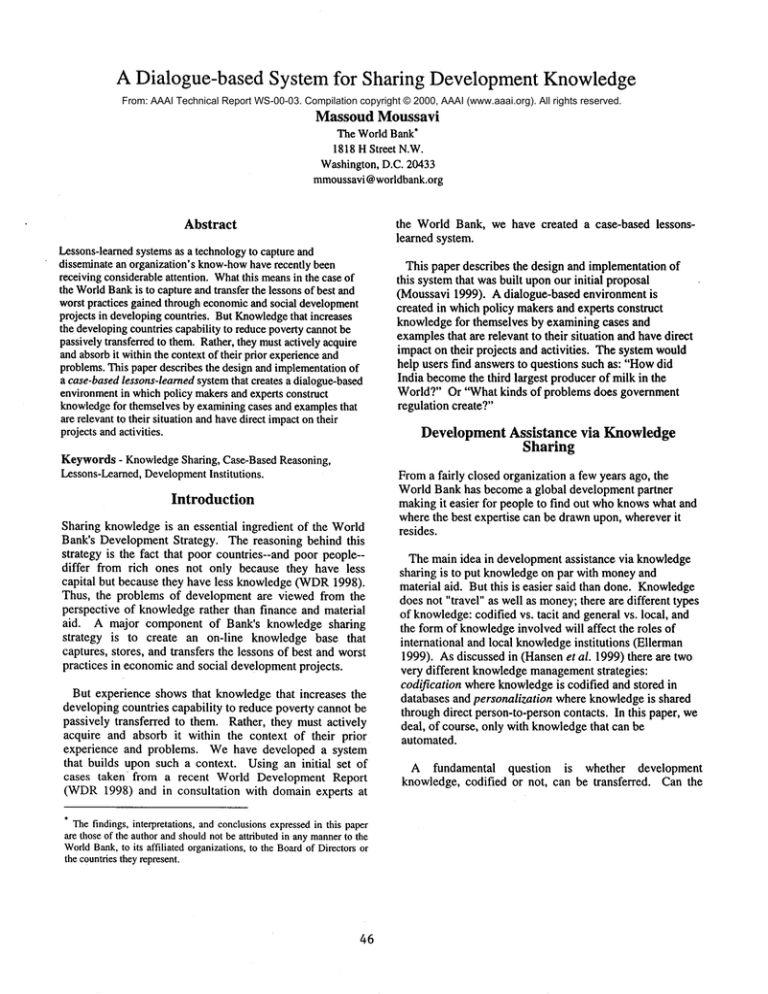
A Dialogue-based System for Sharing DevelopmentKnowledge
From: AAAI Technical Report WS-00-03. Compilation copyright © 2000, AAAI (www.aaai.org). All rights reserved.
Massoud Moussavi
The World Bank*
1818H Street N.W.
Washington,D.C. 20433
mmoussavi@woridbank.org
Abstract
the World Bank, we have created a case-based lessonslearned system.
Lessons-learnedsystemsas a technologyto capture and
disseminatean organization’s know-how
have recently been
receivingconsiderableattention. Whatthis meansin the case of
the WorldBankis to captureandtransfer the lessonsof best and
worst practices gained througheconomicand social development
projects in developingcountries. But Knowledge
that increases
the developingcountries capability to reducepovertycannotbe
passivelytransferred to them.Rather, they mustactively acquire
andabsorbit withinthe contextof their prior experienceand
problems.This paper describes the design and implementation
of
a case-basedlessons-learnedsystemthat creates a dialogue-based
environmentin whichpolicy makersand experts construct
knowledgefor themselvesby examiningcases and examplesthat
are relevantto their situation andhavedirect impacton their
projectsandactivities.
Keywords
- KnowledgeSharing, Case-BasedReasoning,
Lessons-Learned,
Development
Institutions.
Introduction
Sharing knowledgeis an essential ingredient of the World
Bank’s DevelopmentStrategy. The reasoning behind this
strategy is the fact that poor countries--and poor people-differ from rich ones not only because they have less
capital but because they have less knowledge(WDR1998).
Thus, the problems of development are viewed from the
perspective of knowledgerather than finance and material
aid. A major component of Bank’s knowledge sharing
strategy is to create an on-line knowledge base that
captures, stores, and transfers the lessons of best and worst
practices in economicand social developmentprojects.
But experience shows that knowledgethat increases the
developing countries capability to reduce poverty cannot be
passively transferred to them. Rather, they must actively
acquire and absorb it within the context of their prior
experience and problems. Wehave developed a system
that builds upon such a context. Using an initial set of
cases taken from a recent World Development Report
(WDR1998) and in consultation with domain experts
* Thefindings,interpretations,andconclusions
expressed
in this paper
are thoseof the authorandshouldnotbe attributedin anymanner
to the
World
Bank,to its affiliatedorganizations,
to the Boardof Directorsor
thecountriestheyrepresent.
46
This paper describes the design and implementationof
this systemthat was built uponour initial proposal
(Moussavi 1999). A dialogue-based environment
created in which policy makersand experts construct
knowledgefor themselves by examining cases and
examplesthat are relevant to their situation and havedirect
impact on their projects and activities. The system would
help users find answers to questions such as: "Howdid
India becomethe third largest producer of milk in the
World?" Or "What kinds of problems does government
regulation create?"
Development Assistance via Knowledge
Sharing
Froma fairly closed organization a few years ago, the
World Bank has becomea global development partner
makingit easier for people to find out whoknowswhat and
where the best expertise can be drawnupon, whereverit
resides.
The main idea in developmentassistance via knowledge
sharing is to put knowledgeon par with moneyand
material aid. But this is easier said than done. Knowledge
does not "travel" as well as money;there are different types
of knowledge:codified vs. tacit and general vs. local, and
the form of knowledgeinvolved will affect the roles of
international and local knowledgeinstitutions (Ellerman
1999). As discussed in (Hansenet al. 1999) there are two
very different knowledgemanagementstrategies:
codification whereknowledgeis codified and stored in
databases and personalization where knowledgeis shared
through direct person-to-personcontacts. In this paper, we
deal, of course, only with knowledgethat can be
automated.
A fundamental question is whether development
knowledge, codified or not, can be transferred. Can the
best practices of a developing country be replicated in
another? A "best practice" at a companysuch as the Ford
MotorCompanyis general enoughthat it can be replicated
with big savings for the company (Wolford 1999). But
whenit comesto economicdevelopmentit is very difficult
to know a priori just how general a best practice is
(Ellerman 1999). In fact, contrary to popular wisdom,
there are times when it pays to reinvent the wheel? (Cole
1989) and often the local adaptation of a "best practice"
amounts to reinventing the "best practice" in the new
context. Given that there are different and sometimes
conflicting viewpoints concerning developmentissues such
as privatization and fighting corruption, Ellerman argues
that developmentassistance needs to be based on the active
learning philosophy where learners having an active role in
acquiring knowledge. That is, a development institution
such as the World Bank should act as an open learning
institution wheredifferent theories are allowed to publicly
contend and collide, and where experimentation is
encouragedto see what is locally appropriate.
Following the philosophy of the active learning approach
which is the transformation of the student into an active
constructor
and appropriator of knowledge, we are
developing a system that would allow the users form
knowledge for themselves by examining cases that are
relevant to their situation. To develop such a system, two
questions should be addressed: (1) Howcan development
knowledge, which has to do with the content of the
economic and social development projects (one’s
experiences and stories) be represented? And(2) What
the best mechanismto share and transfer such knowledge?
Concerning the first question, knowledgeabout economic
and social developmentis intrinsically case-based. There
is no single best methodto approach development issues.
One deals with a new situation by remembering,modifying
and applying prior experience. That is, one uses case-based
reasoning. Since CBRtechniques provide a mechanismfor
representation and retrieval of experiential information
(Becerra-Fernandez & Aha 1999), a case-based framework
wherelessons-learned and best practices are stored in terms
of cases seems to be a viable method to represent
development knowledge.
As for the transfer of developmentknowledge,the role of
dialogue must be emphasized. In an active learning
environment the cases and questions that are presented
wouldbe relevant to users’ interests and they can actively
construct and appropriate knowledge through a dialogue
with the system.
General
Vs.
Local
Knowledge:
An Example
Information concerning best practices and lessons learned
are usually available in two distinct forms:
¯ general guidelines, lessons and recommendations.
47
¯ local solutions and experiences
Examplesof the general knowledgeare statements such
as the following: "to insure quality of productsestablish
brand names" or "developmentshould rely on private
sector investment.!’ But general knowledgemaynot suffice
to determinelocal solutions as the following case study
clearly demonstrates.It turns out that what contributed to
the success of India’s Dairy Production was farmer-owned
cooperatives and not reliance on the private corporate
sector.
India’s Dairy Production (WDR1998):
"In India in the 1950s, milk production could not keep
pace with growing demand. Somemilk vendors watered
downthe milk. Because there were manyvendors, and
brand nameswere not clearly established, vendors whodid
not dilute their milk could not command
a premiumand
were squeezed out of the market. The result was an overall
drop in milk quality. Enter the National Dairy Development
Board, which in the early 1970s launched Operation Flood,
a multifaceted programto improvethe functioning of the
milk market by ensuring quality. The board began by
encouragingthe creation of dairy cooperatives and helping
themestablish quality standards..."
Werepresent the general knowledgein terms of a set of
rules in a knowledgebase and the specific local solutions in
terms of cases in a case library. Basedon the design
outline described in (Moussavi 1999), we have developed
tool in which lessons learned and case studies documented
in the World DevelopmentReport (WDR1998) and other
WorldBankpublications are stored in terms of cases.
Adaptationof a case is left to the user; the systemonly
helps to retrieve a case that can be adapted and when
possible it suggestsa "best practice."
Question-based
Retrieval:
An Example
The retrieval of cases is closely related to the indexing
method used (Leake 1996). Wehave opted for a hybrid
feature-based and question-based indexing. That is, each
case is partially indexed with a certain numberof features
as well as indexed with a numberof questions that it either
answers or raises (Ferguson et al., 1992). Feature-based
indexingwhichidentifies and stores attribute-value pairs, is
most suitable when the system is used as an advisory and
prescriptive tool. That is, when the user knows the
problem and is looking for a solution. For example, if a
World Bank task manager is working on a health project
say in rural area in Nigeria he/she might want to look at
howa similar problem was addressed before.
Whenthe system is used as an educational rather than
problem solving tool, the question-based indexing seems
most appropriate. There are two major advantages of a
question-based indexing: it generates interest in the topic
and it engages users in a dialogue. Both are crucial in the
process of active learning and knowledgediscovery.
To index a case, using the model of ASKsystems
(Ferguson et al. 1992; Schanket al. 1991), we analyze the
content of each case, for the questions that it answersand
also for the questions that it raises. Someof such questions
concerning the example on India’s Dairy Production that
we discussed earlier wouldbe as follows:
¯
¯
¯
"Whydid the state intervene in the case of milk
production in India?"
"Howdo brand names provide quality assurance?"
"What kinds of problems does government regulation
create?"
Figure 1 shows an interaction with a user. The user is
first promptedto choose a particular country and topic of
interest. (In this example, we have only showncountry and
topic as the only indexed features. However,the case-base
is indexed with more features.) Once the user selects
country and a topic, a list of relevant questions are
displayed.
’*xv*,v~i~C
~0Wlhi
eOJc~0~
c~~.,~
IC~etem,~a
iifl ~t~e0th
..........
".B~=,r
--
KnowledgeRepresentation
Wehave taken a minimal representation approach (Edelson
1993) where the primary research is concerned with
representing as little as possible about the domainand yet
achieve the educational goal of the system. That is a casebased knowledge-sharing tool need not know muchabout
what it teaches. Rather it should be able to provide users
with the information that they need.
To create a database of cases, we model in terms of
objects and relationships between them. The objects
include cases, questions and rules. Twobroad classes of
cases are identified as theoretical cases that explain
economic and development theories and principles and
specific cases whichdescribe lessons learned from specific
projects. Questions are also broken into two classes
general questions (e.g., "Whyregulate?") and specific
questions (e.g., "Howdid Ghanaimplement a successful
telecom reform?") As discussed earlier,
rules are
statements that prescribe a particular action or contain a
recommendation.As for relationships amongobjects, the
most important relationship is the ones between cases and
questions. A case is linked to questions that it raises or
answers.
Eachcase is represented in terms of a numberof indexed
features or attributes (geographicalregion, country, sector,
topic, etc.) and a text field that contains the description of
the situation, the solution and the outcome.Since there is a
natural abstraction hierarchy betweensomeof the attributes
(e.g., region and country), the objects are further
categorized into subclasses.
~ IHo,*~ ~ becu.eto ,~Z’se~-te~st0~oeucer
a ~?
iMI
In India in the 1950s,milkproductioncouldnot keeppacewith growing
demMd.
Some
~lk vendorsresponded
bywateringdownthe milk.Theycoulddothis with rel~live
imptmity
becauseconsumers
couldnot deteemine
whichmilkwasdilutedbeforebuyingit
Andbectasethere weremmy
vemiore,tad breadnameswerenot clearly established,
vendorswhodid net dilute their milkcouldnot command
a premium
tad weresqueezed
out of the merketThere~,dtwasta overalldropin milkquality.Euterthe NationalDai~
Develegmeut
Board,whichin the early 1970slumched
OperationFlood,a umltifaceted
progrum
to improve
the functioningof the milkmarketbyensuringquality.
Theboardbegtabyencouraging
the creationof dauycooperativestad helpingS!
themestablishqualitysteadards.Theboarddistributeda simple,hami-operuted
device i~!i
for testing butterfat contentto eachvillagecoupet~ve
that collectedmilkfromfarmers ~
endto distributorstad marketing
agents.Thisstreagthened
the incentivesfor producing
andmarketingquality milk. Ne~the boardtook ateps to improvea~dfamdardizemilk~’~
Wehave represented 100 cases and 70 questions taken
from The World Development Report (WDR1998) and
other Bankpublications in a relational database. All the
cases have been indexed with a numberof attributes such
as region, country, sector, sub-sector, etc. Currently, about
50 cases are linked to questions. The cases are fairly small
with textual parts not exceeding 500 words. Framing
questions was fairly straightforward as a numberof the case
studies in these publications posed a major question as part
of their titles.
qua!itybyprovidingCoupermive~
with te¢lmicalresistance,~nchas improved
feed,
Figure 1: The User Interface
The interface allows the user to browse the case-base by
Figure 1: The User Interface selecting one or more
questions. Once a case is displayed, the user can browse
related cases by clicking on the "Related Questions" button
and then selecting one of the related questions. This cycle
continues until the user is satisfied. Adaptationof cases in
this system is left up to the user as adapting development
knowledge to local conditions and culture requires
considerable effort (Ellerman, 1999).
/48
Discussion
Wehave built an interactive case-based system using a
"conversational CBR"framework (Aha and Breslow 1997)
that allows users to navigate through a library of case
studies to find an examplethat is similar to their situation.
This is achieved by promptingusers to answer questions on
indexed features. Additionally, we have created cross links between a riumber of cases by indexing those cases
with questions that they raise or answer. The users will be
able to browsthe case library.by selecting a question that
interests them, retrieve a case and browsother related cases
by selecting one or morequestions. In effect, an active and
participatory learning environmentis created.
The tool was developed using Microsoft Visual Basic to
build the user interface and the CBRengine. Wehave also
created a Webenabled interface to the database. The
advantageof a Webinterface is that it wouldallow for easy
integration of other sources of information concerning the
country or the topic.
Building a case-based system to represent development
knowledgeis a big challenge because it implies indexing a
large numberof documents. One of the main issues is how
to scale up. We are currently exploring document
summarization techniques (McKeown 1999; Mani and
Bloedorn 1999) so that a larger number of documents can
be indexed more economically. At the same time we are
investigating the applications of semi-automatedindexing
techniques (Bruninghaus and Ashley 1999) in the area
development information. We will also research the
applicability of adaptation techniques to retrieval of
relevant cases. Adaptation-guided retrieval is a novel
technique that assesses the adaptation requirementsof cases
during retrieval (Smyth and Keane, 1995).
Summary
The paper illustrates
our approach in constructing a
knowledge-sharing tool to capture and represent economic
and social development knowledge. The system is based
on a conversational modelthat anticipates users’ questions
concerning development issues. Using this tool, policy
makers and experts form knowledge by examining cases
and examplesthat are relevant to their situation and have a
direct impact on their projects and activities. The system
provides the following benefits:
¯
¯
¯
¯
¯
A unified frameworkto represent the lessons learned
and best practices concerning economic and social
development.
Active and participatory learning occurs because the
examplesand questions are couched in terms of what
makessense from the user’s viewpoint and interests.
Knowledge is not transferred to users through a
sequence of lectures. Rather, it is acquired by them at
their own speed through a series of structured
questions.
Providesa better user interface so that the users do not
need to have extensive prior knowledge about the
domain in order to find what they want in the
knowledgebase.
A deeper level of knowledgeis obtained because of the
cross-links betweensimilar cases. A system that links
related experiences would have significantly higher
operational value.
Acknowledgements
I wouldlike to thank the AAAIreviewers for their helpful
commentsand feedback.
References
Aha, D. W. and Breslow, L.A. (1997). Refining
Conversational Case Libraries. In Proceedings of the
Second International
Conference on Case-Based
reasoning, pages 267-278. Providence, RI: SpringerVerlag.
Becerra-Fernandez, I., and Aha, D.W. (1999). Case-based
problem solving for knowledge managementsystems. In
Proceedings of the Twelfth Annual Florida Artificial
Intelligence Research Symposium. MenloPark: AAAI.
Bruninghaus, S. and Ashley, K.D. (1999). Bootstrapping
Case Base Development with annotated Case Summaries.
In Proceedings of the Third International conference on
Case-Based reasoning (ICCBR-99). Lecture Notes in
Artificial Intelligence 1650. Althoff, K.-D., Bergmann,R.,
and Branting, L.K. (ed.) pp. 59-73. Springer:Berlin.
Cole, R. (1989). Strategies
University of California Press.
for Learning. Berkley:
Edelson, D.C. (1993) Learning from Stories: Indexing and
Reminding in a Socratic Case-Based Teaching System for
Elementary School Biology.
Dissertation Thesis.
Northwestern University.
Ellerman, D. (1999). Global Institutions:
Transforming
International
Development Agencies into Learning
Organizations. The Academy of Management:Executive,
V. 13 (1, Feb. 99), pages 25-35.
Ferguson, W., Bareiss, R., Birnbaum, L., and Osgood, R.
(1992). ASKSystems: An Approach to the Realization
Story-based Teachers. Evanston: The Institute for the
Learning Sciences.
Hansen, M.T., Nohria, N., and Tireney, T. (1999). What’s
Your Strategy For Managing Knowledge. Harvard
Business Review, March-April 1999, pages 106-116.
Leake, D. (1996). CBRin Context: The Present and
Future. In D. Leake, editor, Case-Based Reasoning:
Experiences, Lessons, & Future Directions, pages 3-30.
Menlo Park, CA: AAAIPress.
Mani, I., Bloedorn, E. (1999) SummarizingSimilarities
and Differences AmongRelated Documents. Information
Retrieval 1(1): 35-67.
McKeown, K. (1999)
Toward Multi-document
summarization by Reformulation: progress.
In
Proceedings of the National Conference on Artificial
Intelligence (AAAI-99). Menlo Park: AAAI.
Moussavi, M. (1999). A Case-Based Approach
Knowledge Management. In Aha, D.W., BecerraFernandez, I., Maurer, F., & Mufioz-Avila, H. (Eds.)
Exploring Synergies of KnowledgeManagementand CaseBased Reasoning: Papers from the AAAI Workshop
(Technical Report WS-99-10). Menlo Park, CA: AAAI
Press.
Schank, R., Ferguson, W., Birnbaum, L., Barger, J., and
Greising,
M. (1991). ASK-TOM:An experimental
interface for video case libraries. In Proceedings of the
Thirteenth Conference of the Cognitive Science society.
Northvale, NJ: Erlbaum.
Smyth, B., and Keane, M.T. (1995). Experiments
adaptation-guided retrieval in case-based design. In
Proceedingsof the First International Conferenceon caseBased Reasoning, pages 313-324. Sesimbra, Portugal:
Springer-Verlag.
WDR(1998). Knowledge for Development: The World
Bank World Development Report. The World Bank.
Wolford, D. (1999). Best Practice Replication at FORD.
Knowledge Management Review. September/October
1999.
50

